FoxO3a (Forkhead Box O3a) deficiency protects Idiopathic Pulmonary Fibrosis (IPF) fibroblasts from type I polymerized collagen matrix-induced apoptosis via caveolin-1 (cav-1) and Fas
- PMID: 23580232
- PMCID: PMC3620276
- DOI: 10.1371/journal.pone.0061017
FoxO3a (Forkhead Box O3a) deficiency protects Idiopathic Pulmonary Fibrosis (IPF) fibroblasts from type I polymerized collagen matrix-induced apoptosis via caveolin-1 (cav-1) and Fas
Abstract
Idiopathic Pulmonary Fibrosis is a lethal fibrotic disease characterized by the unrelenting proliferation and persistence of fibroblasts in a type I collagen-rich matrix that result in an expanding reticular network of fibrotic tissue. However, the underlying mechanism responsible for the persistence of myofibroblasts in IPF remains unclear. During normal tissue repair, unwanted fibroblasts are eliminated during collagen-matrix contraction by a mechanism whereby high PTEN activity suppresses Akt. We have previously found that FoxO3a, a transcriptional activator of apoptosis-inducing proteins, is inactivated in IPF fibroblasts resulting from aberrantly high PI3K/Akt activity due to inappropriately low PTEN activity. Here we demonstrate that this low FoxO3a activity confers IPF fibroblasts with resistance to collagen-mediated apoptosis. We show that the mechanism by which low FoxO3a activity confers IPF fibroblasts with an apoptotic resistant phenotype involves suppression of Fas expression as a result of down regulation of cav-1 expression via a PTEN/Akt-dependent pathway. We demonstrate that PTEN over-expression or Akt inhibition increases FoxO3a expression in IPF fibroblasts, resulting in up-regulation of caveolin-1. We show that FoxO3a binds to the cav-1 promoter region and ectopic expression of FoxO3a transcriptionally increases cav-1 mRNA and protein expression. In turn, we show that overexpression of caveolin-1 increases Fas levels and caspase-3/7 activity and promotes IPF fibroblast apoptosis on polymerized type I collagen. We have found that the expression of caveolin-1, Fas and cleaved caspase-3 proteins in fibroblasts within the fibroblastic foci of IPF patient specimens is low. Our data indicate that the pathologically altered PTEN/Akt axis inactivates FoxO3a down-regulating cav-1 and Fas expression. This confers IPF fibroblasts with an apoptosis-resistant phenotype and may be responsible for IPF progression.
Conflict of interest statement
Figures

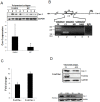
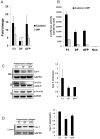

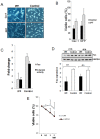
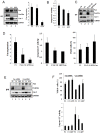

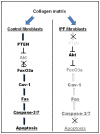
References
-
- Gharaee-Kermani M, Gyetko MR, Hu B, Phan SH (2007) New insights into the pathogenesis and treatment of idiopathic pulmonary fibrosis: a potential role for stem cells in the lung parenchyma and implications for therapy. Pharm Res 24: 819–41. - PubMed
-
- Ryu JH, Colby TV, Hartman TE (1998) Idiopathic pulmonary fibrosis: current concepts. Mayo Clin Proc 73: 1085–101. - PubMed
-
- Ask K, Martin GE, Kolb M, Gauldie J (2006) Targeting genes for treatment in idiopathic pulmonary fibrosis: challenges and opportunities, promises and pitfalls. Proc Am Thorac Soc 3: 389–93. - PubMed
Publication types
MeSH terms
Substances
Grants and funding
LinkOut - more resources
Full Text Sources
Other Literature Sources
Molecular Biology Databases
Research Materials
Miscellaneous

